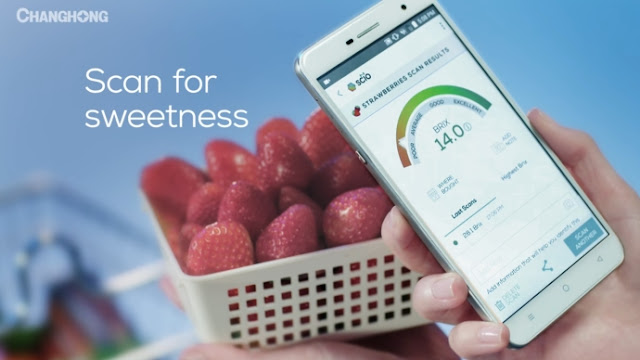Does anyone really need a phone that can tell what you’re eating?
It’s obvious that the craziest, most daring, most innovative smartphone manufacturers aren’t in South Korea or California, but in China, where they toil away in relative obscurity. Chinese manufacturers are risk takers, and they’re prepared to try things that their larger rivals wouldn’t dare.
Where am I going with this? Well, earlier today, I stumbled upon the ChangHong H2, and my jaw dropped. Just watch the video above, and you’ll see what I mean.
In short, the ChangHong H2 is a phone with its own integrated spectrometer, allowing it to identify the composition of objects.
It’s a bit like a tricorder from Star Trek. According to the promotional video, if you show it a punnet of strawberries, it will show you how sweet they are. And if you scan your biceps, it’ll give you a breakdown of how much body fat you have, as if the pendulous swinging of your bingo wings wasn’t enough of a clue.
You could be forgiven for being skeptical. The ChangHong H2 promises a lot. And as we’ve seen time-and-again on crowdfunding sites like KickStarter and IndieGogo, there’s a lot of bullshit out there.
But this looks promising. For starters, the technology isn’t that far-fetched. As we’ve seen in various other consumer technology products, spectrometers are increasingly more affordable and crucially, smaller.
Furthermore, the manufacturer of the phone, Sichuan Changhong Electric Co, has teamed up with Analog Devices Inc, who are a huge components manufacturer. Given they employ over 9,000 people and are listed on the Nasdaq, you can safely assume they’re legit.
But let’s take an ice cold shower of cynicism.
The sensor itself is based on Consumer Physics’s SCiO molecular sensor, which is a product you can actually buy today. It exists.
But here’s the kicker. The original product was the subject of a fraught crowdfunding campaign, which saw it taken down over an intellectual property dispute with another company. When the sensor eventually made its way to punters, reviews were decidedly negative.
While it worked on a fundamental level, the original version of SCiO wasn’t accurate to the point where you’d reasonably feel comfortable enough using it to identify medicines. From the above TechCrunch article:
Two bloggers who know the SCiO creators doggedly scan various fruits and enjoy good, usable results. Then, on a whim, they scan an M&M using the profile for “pain relievers.” Instead of failing, the scanner suggests that the blue M&M contains ibuprofen. It’s enough to make you wonder if there isn’t something else going on besides molecular scanning, a question that will hound the creators until these things finally ship.
Maybe the Consumer Physics’s tech has improved since last September, but I’m not holding my breath.
For the sake of fairness, the Changhong H2 debuted at CES earlier this year. Both PhoneArena and The Verge got their hands on it, although it’s worth remembering that trade shows aren’t always the best places to critically assess a product. I’d be curious to see how it performs in a less-controlled environment, away from the watching eyes of whoever is manning the booth.
I guess the biggest question I’ve got is who actually will buy it. Besides the novelty factor, what’s the point?
Industry is out, as any serious professional will be using more expensive dedicated gear. And over the hour I spent writing this piece, I racked my brains to think of a single reason why Joe Consumer would stump for a spectrometer-clad phone. I couldn’t think of one.
Yes, the ChangHong H2 is a crazy, innovative piece of hardware. But innovation doesn’t always lead to something you’d want to use.
Discover more from Applygist Tech News
Subscribe to get the latest posts sent to your email.

